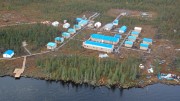Brazil’s political and economic turmoil has grabbed headlines around the world, the culmination of years of top-level judicial investigations and countrywide street protests against corruption in politics.
On May 12, a year and a half into her second term and after touching an approval-rating low of 9% last July, Brazilian President Dilma Rousseff was removed from office, stepping down for 180 days to face an impeachment process that will examine whether she violated the country’s law on fiscal responsibility.
Vice-President Michel Temer has replaced Rousseff as Brazil’s leader, and he quickly assembled a government that many are describing as a 1990s-style “neoliberal” one. Meanwhile Rousseff and her supporters in the left-leaning Workers’ Party (PT) and beyond are defiant, and describe the past week’s events as a “non-military coup.”
More than half the members of Brazil’s multiparty Congress are being investigated as part of a massive corruption scandal revolving around state majority-owned oil and gas giant Petrobras.
While Petrobras was partly privatized in the 1990s by Brazil’s centrist government at the time, the PT government of Rousseff’s predecessor Luiz Inacio Lula da Silva steadily restored government control over Petrobras during his eight-year rule that ended in 2010.
Petrobras’ discovery of the massive, so-called “pre-salt” deepwater offshore oilfields in 2007 turned the question of who would own Petrobras and operate the newfound offshore discovery into a highly nationalistic one within Brazilian politics, as Petrobras embarked on the biggest corporate capex program in the world.
When the Brazilian government took control, Petrobras’ top executive positions were filled with PT party members and coalition partners, led by Paulo Roberto Costa, who secretly diverted funds valued at up to 3% of all contracts to the PT and its coalition partners. With such a large capex program underway, this amounted to billions of dollars in inflated contracts and bribes, with corrupt Petrobras directors colluding with contractors that included some of Brazil’s biggest construction companies.
Some Petrobras directors accumulated illegal funds of more than US$100 million in Swiss bank accounts, while others bought pricey art collections.
Last year, investigators revealed that — mostly when Rousseff was chairman of the Petrobras board from 2003 to 2010 — at least US$1.7 billion was spent on bribes, and losses to the state through bribes, inflated contracts and related misspending totalled somewhere between US$8.3 billion and US$12 billion.
Investigators have so far charged 179 people with crimes tied to the Petrobras scandal, and have convicted 93.
The current investigation of Rousseff and her possible violation of the country’s fiscal responsibility laws is pretty mild in comparison, and has to do with the pedaladas (“bicycle pedal”) process of having the government take off-the-book, short-term loans from government-owned banks — with the borrowed funds mainly used to subsidize big business — but then not being able to pay them back as the government’s fiscal situation deteriorated, due to the fall in commodities markets and the deep bite of corruption at Petrobras.
This in turn compromised the activities of Brazil’s central bank and led to high inflation rates, such as 10% in 2014.
This latest political drama in Brazil is taking place against a backdrop of a ballooning deficit, sharply lower oil prices, layoffs and chronic structural inefficiencies in the Brazilian economy. The country’s gross domestic product is set to drop 3–4% this year after having grown steadily from 2003–14 in tandem with the global commodities boom, and Brazil’s unemployment rate has swelled to 12%, as a quarter of the population live below the poverty line.
It’s not all gloom in Brazil’s commodities industries, though. Brazil’s biggest miner, Vale, surprised the market in late April with a relatively strong first quarter — posting its first profit in three quarters — that set it up as the best-performing major iron-ore miner this year, thanks to cost cuts, rebounding iron ore prices and a stronger real.
Vale’s net income in the first three months of 2016 was US$1.8 billion, compared with a US$3.1-billion loss a year ago.
While falling oil prices have walloped Petrobras, Vale has enjoyed lower freight costs to send its iron ore by ship from Brazil to China — a longer distance to China than for its rivals BHP Billiton, Rio Tinto and Fortescue Metals, from their massive export operations in Australia. Year-over-year, Vale saw a 32% cost reduction in delivering iron to its Chinese customers.




Be the first to comment on "Editorial: Brazil’s anti-corruption drive takes out Rousseff"